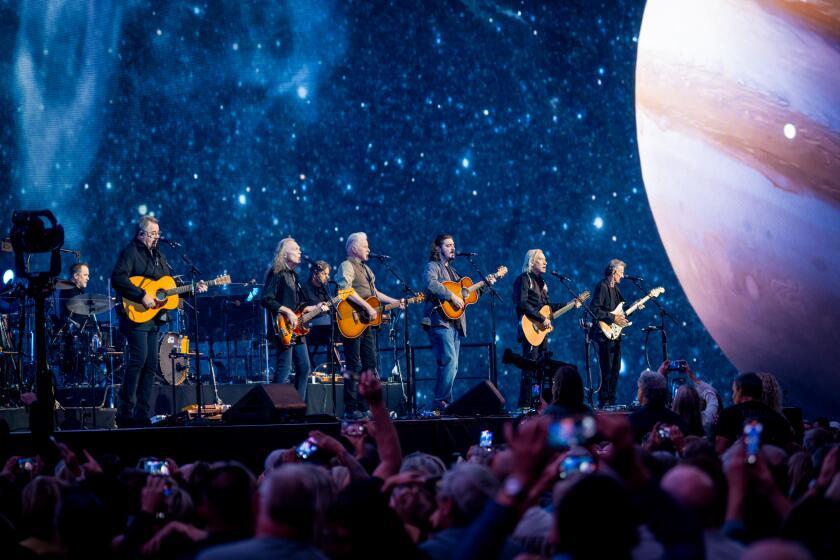POP MUSIC REVIEW : Mayall Provides a Welcome Dose of Authenticity
SAN JUAN CAPISTRANO â After a week of media immersion in Milli Vanilliâs fudging, it was a relief to hunker down with some certified-honest goods Friday night at the Coach House.
John Mayall and the Bluesbreakers. Real roots. Real guitars. Real harmonica. Real singing. Oh yes, and some lip-syncing.
Lip-syncing!!! Et tu, Mayall?
Donât worry, folks. The blues republic hasnât fallen. When it comes to 12-bar traditionalism, Mayall is still the noblest Briton of them all. This was honest lip-syncing--a fun bit of musical ventriloquism in which guitarist Coco Montoya played a mouth-flapping Charlie McCarthy while his sweet Stratocaster made like Edgar Bergen. While his fingers elicited deep, masculine harrumphs and falsetto female protestations from the guitar, Montoyaâs lips silently mimicked a couple in the midst of an animated domestic tiff.
The humor went down well with the near-capacity crowd, and so did the more serious, high-impact fretwork that Montoya displayed during the rest of his long solo spot. The fact that the guitarist got the biggest ovation of the nearly two-hour show called to mind another Mayall tradition: The bandleaderâs long career has been as much a forum for his guitar-hero sidemen as for himself.
Nevertheless, the latest Bluesbreakers lineup, which also includes bassist Freebo and a very solid drummer, Joe Yuele, has Mayall steppinâ out a bit more than he did during the mid- to late â80s. During those years, Mayallâs band was a five-piece with two dominant guitarists, Montoya and Walter Trout. The Huntington Beach-based Trout left in 1989 to front his own band full time. Rather than replace him, Mayall went on with a four-piece lineup, giving himself more room to move, as it were.
Mayall, who turns 57 on Thursday, moved with plenty of good-natured vigor as he blew lots of harmonica, played some nice chingy-jangly rhythm guitar and took extended glides along his digital keyboard, which alternately sounded like an organ and a piano (not to mention some passable flute tones and some too-gimmicky ersatz sax). But the concert was mainly a low-keyed, easygoing affair that could have used more of a jolt. While it rolled along enjoyably, it lacked the searing, emotive moments that can turn a blues show from an amiable, toe-tapping night out into something more intense and revealing.
The material may have had something to do with that. Mayall drew most of it from his current album, âA Sense of Place,â a collection of swampy, down-home tunes with a prevailing back-porch blues feel. Having recently regained major-label status after a long spell of recording for small companies, Mayall clearly wasnât in a mood for looking back. He opened with âAll Your Love,â from the classic 1965 âBluesbreakersâ album, and closed with his signature harp-riffer, âRoom to Move.â In between, everything but Montoyaâs spotlight number was drawn from Mayallâs two recent Island Records releases. That wasnât a real problem, because the material on âA Sense of Placeâ and the 1988 album, âChicago Line,â is varied and stands up well. But Mayall could have profitably resurrected one or two early songs in place of a number like âCongo Square,â a voodoo-themed New Orleans piano strut that didnât come close to replicating the distinctive bounce and roll of such native New Orleans players as Art Neville and Dr. John. Mayall played to a stronger suit with the old-time barrelhouse piano style of âSend Me Down to Vicksburg.â
Mayallâs singing also failed to summon up the psychological drama of the highest-intensity blues. With its high, reedy, cottony quality, Mayallâs voice is distinctive enough to be readily identifiable, but it is far from trenchant.
On âSensitive Kind,â in which the singer counsels another man to deal tenderly and considerately with women, Mayallâs mild delivery made the advice sound temperate, almost fatherly. It was left to Montoya to raise the emotional stakes. After underscoring the tender mood, and womenâs sadness, with cushioned, string-massaging tones, he moved to taut, rapid runs that elevated the drama.
Mayallâs encore offered a nice treat: a guitar duet (as opposed to duel) between Montoya and Debbie Davies, whose band had opened with a solid hour given mainly to blues standards that showcased her clean, nimble guitar style.
Montoya and Davies live together, and they played together with fine responsiveness. At one point, the left-handed Montoya let loose with a flying speed run. In many circumstances, the next player up would take that as a challenge, a feat to be duplicated or outdone. Instead, Davies chose to play something contrasting and complementary--some chunky, rhythmic Chuck Berry licks. The interlude ended with a tandem harmony passage that made you think that love really is grand, especially when two sharp guitar players are expressing it together.
Having gotten Vanilli goo all over itself, the recording arts academy that runs the Grammy Awards would do well to look toward Mayall for a much-needed helping of musical authenticity. In the quite possible event that âA Sense of Placeâ is nominated in the category of best contemporary blues recording, the Grammys should can the lip-sync brigade and turn over a good chunk of its telecast to Mayall and his eminent alumni association (the leading lights being Eric Clapton, Mick Taylor, Peter Green, John McVie and Mick Fleetwood). Since 1990 marks the 25th anniversary of âBluesbreakers,â the first great blues-rock guitar album, it would make a lot of sense.
More to Read
The biggest entertainment stories
Get our big stories about Hollywood, film, television, music, arts, culture and more right in your inbox as soon as they publish.
You may occasionally receive promotional content from the Los Angeles Times.











